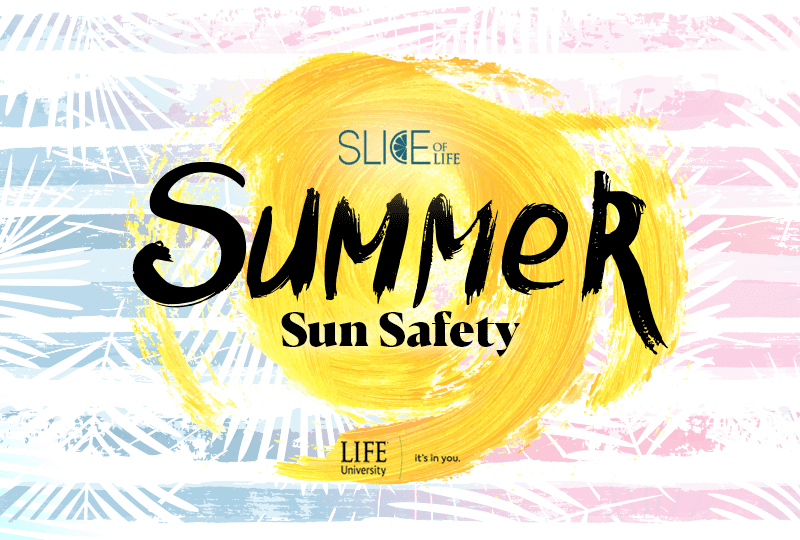Summer Sun Safety
Don’t you just love summer? The long, lazy days by the lake, pool or beach make us feel content and alive. Here at Life University (Life U), some of our students that did not choose to enroll in the Summer Quarter are spending some much-needed extended relaxation time out and about, most likely soaking up some sun and fresh air.
We all know that spending time outside is healthy as we stay more active, reduce stress and increase vitamin D levels. Yet, too much of a good thing can be damaging, so here’s your reminder to take care of your body’s most exposed organ: your skin.
Working on the perfect tan might be fashionable, but sunburn, sun damage and even skin cancer are certainly not. On its “Sun Safety” page, the Center for Disease Control (CDC) offers many resources and plenty of information about how to protect yourself from overexposure to Ultraviolet (UV) rays, the invisible radiation emitted from the sun, as well as tanning beds and sunlamps.
For example, it connects you to a very helpful tool that predicts UV levels on a scale ranging 1-11+ (one being the lowest level of present UV rays). Simply type in your zip code or city, and then a UV forecast for your area will be displayed, giving guidance on how to minimize sun exposure throughout the day.
Practical Sun Protection Methods
- Got it made in the shade- Staying under a bit of shade from a tree, umbrella or other shelter can go a long way toward reducing sun damage or skin cancer risk. However, it’s still a good idea to wear sunscreen and protective clothing outside even in the shade or on shady days. UV rays can be sneaky and deceptive, doing more harm than is perceptible, especially if the day doesn’t feel especially hot due to wind or other factors.
- Stick to a sun-safe dress code- When possible, it’s smart to wear long-sleeved shirts, long pants or skirts, which can all provide protection from UV rays. If this type of clothing isn’t practical, wear a T-shirt or beach cover-up. Clothes made from tightly woven fabric offer better protection. A dry shirt is more effective at blocking UV rays then a wet one and darker colors can offer more protection than lighter ones. Lastly, some clothing can be purchased that are certified under international standards as offering UV protection.
- The hat’s all that- The best kind of hat to protect your face is wide-brimmed, going all the way around and shading your face, ears and the back of your neck. Avoid straw hats with holes. A darker hat may offer more protection. A baseball cap is also good, if complemented with other sun protection methods.
- Got glasses? – Sunglasses shield your eyes from the harshness of the sun, reducing the risk of cataracts as well as protecting the soft skin surrounding the eye from sun exposure. Sunglasses that block both UVA and UVB rays offer the best protection, and luckily most sunglasses sold in the United States meet this standard. Wrap-around sunglasses are best because they block UV rays from sneaking in from the side.
- Last but not least, Sunscreen- According to the CDC’s blog “The Truth About Sunscreen: 7 Facts That Will Set You Straight for Skin Protection This Summer,” there is a fair amount of misinformation and misuse out there related to sunscreen. The story discusses how studies have been conducted that show that people often use less sunscreen than is required to effectively protect against the sun.
Use more than you think you need of broadband spectrum sunscreen that is a minimum of SPF 15. Imagine what you would need to fill a shot glass full for the entire body and roughly a fourth to a half a teaspoon for the face. That should be your basic measure for how much is needed for one application, and in fact, use measuring tools if that is simpler. Sunscreen should be reapplied, at minimum, every two hours, as well as after swimming, sweating or toweling off.
Lastly, be sure not to use sunscreen that is past its expiration date, as it won’t likely be effective and may even cause skin irritation. Check the expiration date before use. Sunscreen without an expiration date has a shelf life of no more than 3 years. Shelf life is shortened if the product has been exposed to high temperatures.
Slice of LIFE is an invitation to and extension of everything happening at Life U. Whether you are a current student, a potential freshman or a proud alumni, Slice of LIFE can help keep you connected to your academic community. Know of a compelling Life U story to be shared, such as a riveting project, innovative group or something similar? Let us know by emailing Marketing@life.edu.


Social Media